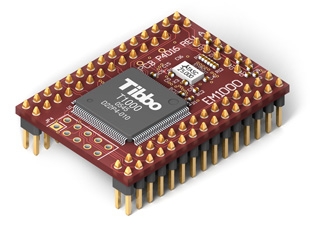EM1000 BASIC/C-Programmable Ethernet Module

Please be sure to read the following topic: EM1000-00 and -01/-02.
Introduction
At it's launch, the EM1000 was Tibbo's most powerful and versatile Tibbo BASIC/C-programmable embedded module.
The module's hardware is a potent combination that includes a 10/100BaseT Ethernet port, four serial ports, onboard flash, EEPROM, RTC with onboard backup power, and abundant I/O lines (up to 54!) to interface with an external LCD, keypad, buzzer, and card readers. Thus, the EM1000 is perfect for designing data collection and automation products, such as access control panels, time and attendance terminals, inventory control systems, factory floor automation terminals, and the like.
The EM1000 is also excellent for prototyping your projects — its pin pitch is the standard 2.54mm (0.1).
The EM1000 is fully supported by Tibbo IDE (TIDE) and a dedicated EM1000 platform that covers all hardware facilities of the module. For convenient testing and evaluation, Tibbo offers the EM1000TEV and EM1000EV development systems. The EM1000 also supports Wi-Fi communications (this requires the WA2000 add-on module).
Hardware Features
- 10/100BaseT auto-MDIX Ethernet port (standard Ethernet magnetics are NOT integrated into the module)
- Optional Wi-Fi interface (requires the WA2000)
- Can control a GPRS modem* (such as the SIM900)
- Four high-speed serial ports (CMOS-level):
- Baudrates of up to 921,600bps
- None/even/odd/mark/space parity modes
- 7/8 bits/character
- Full-duplex mode with RTS/CTS and XON/XOFF flow control
- Half-duplex mode with direction control
- Encoding and decoding of Wiegand and clock/data streams
- 54 general-purpose I/O lines; eight lines can work as interrupts
- Square wave output (can be used for buzzer* control)
- Four synchronous serial ports with SPI and I²C modes
- Supports LCD and OLED panels*
- Supports matrix and binary output keypads*
- RTC with dedicated backup power input; optional onboard supercapacitor
- 22KB SRAM for Tibbo BASIC/C variables and data
- 1MB flash memory for TiOS, application code, and file system
- 2,048-byte EEPROM for data storage
- Four control lines for external status LEDs:
- Two control lines for green and red main status LEDs
- Two control lines for Ethernet "link" and "100Mb" LEDs
- Software and hardware-controlled PLL for selecting high or low speed
- Reliable power-on/brown-out reset circuit
- Power: 230mA @ 3.3V (100Base-T mode, full speed)
- Dimensions (LxWxH): 38.4 x 28.4 x 5.5mm
- Prototyping-friendly 2.54mm (100mil) pin pitch
- Operating temperature range: –40°C to +70°C
- Firmware and compiled Tibbo BASIC/C app can be updated through the serial port or Ethernet LAN
- Tibbo BASIC/C application can be debugged through the Ethernet LAN (no additional debugging hardware is required)
- CE and FCC-certified.
* Must be connected externally.
Programming Features
The EM1000 runs Tibbo OS (TiOS). The following is a list of the features supported by its programming platform:
- Objects:
- beep — generates buzzer patterns
- button — monitors the MD (setup) line
- fd — manages the flash memory file system and direct sector access
- io — handles I/O lines, ports, and interrupts
- kp — works with matrix and binary keypads
- lcd — controls graphical display panels
- net — controls the Ethernet port
- pat — "plays" patterns on up to five LED pairs
- ppp — accesses the Internet over a serial modem (GPRS, etc.)
- pppoe — accesses the Internet over an ADSL modem
- romfile — facilitates access to resource files (fixed data)
- rtc — keeps track of date and time
- ser — controls serial ports (UART, Wiegand, clock/data modes)
- sock — socket comms (up to 16 UDP, TCP, and HTTP sessions)
- ssi — controls serial synchronous interface channels (SPI, I2C...)
- stor — provides access to the EEPROM
- sys — in charge of general device functionality
- wln — handles the Wi-Fi interface
- Variable Types: Byte, char, integer (word), short, dword, long, real, string, plus user-defined arrays and structures
- Function Groups: 27 string functions, eight date/time conversion functions, encryption/hash calculation functions (RC4, MD5, SHA-1), and more
